We design and build automation solutions.
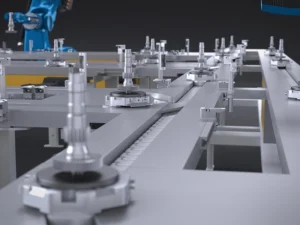
EWAB Systems
Conveyor systems for high-volume capacity and smooth, reliable flow. Easily manage mixed product families to keep your machines fed. EWAB also provides customised solutions, including tabletop systems, roller, belt, and chain conveyors tailored to your needs.
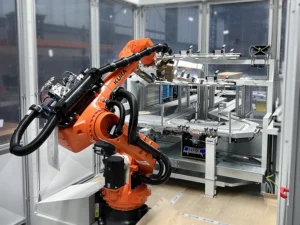
Robot Cells
EWAB’s robot cell solutions are engineered to meet your specific production needs. Compact, adaptable platforms with standardized interfaces—perfect for efficient machine loading and material handling.
Visions systems, bin picking, quality control and more.
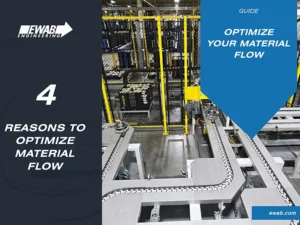
Guides
Explore how a dependable and efficient automation solution can revolutionize your processes, becoming a game changer that elevates productivity and drives remarkable improvements. Download guides here!

The Flow Expert
In our EWAB flow seminar you will learn how a proper workpiece flow in production will help you to achieve operational excellence.
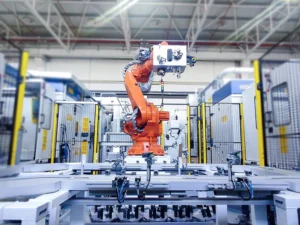
Industries
Solutions for high performance products, reliable, robust and for many different industries. EWAB system solutions are present globally, utilized by OEMs and Tier 1 & 2 suppliers.
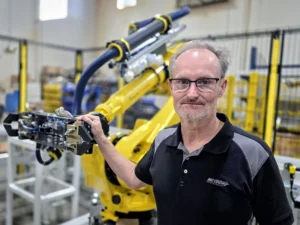
Project Management
What is your experience from complex automation projects that involves several suppliers and internal and external people?
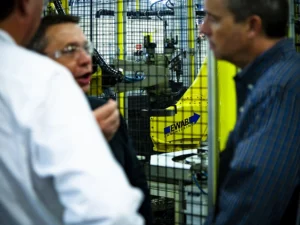
Collaboration
Our extensive experience demonstrates that collaboration represents the optimal path toward achieving outstanding outcomes.
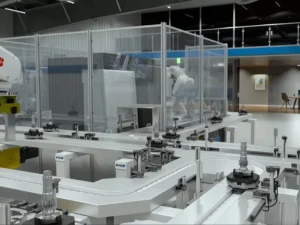
Vizualization
Design your concept ideas with a pallet conveyor system to efficiently transport parts between operations. Visualise the layout before starting your new investment project.
We help you with automation solutions
In industrial automation, achieving operational excellence necessitates a harmonious blend of experience, expertise, authoritativeness, and trustworthiness. The EWAB Group exemplifies these principles, setting global benchmarks in efficiency and quality for workpiece carrier systems. With over five decades of industry experience, EWAB meticulously designs automation solutions tailored to the unique needs and objectives of each client.
Comprehensive Automation Solutions
EWAB’s conveyor solutions, often referred to in the industry as pallet conveyors, chain conveyors, or in-plant logistics systems, are more accurately described as workpiece carrier systems. These systems are engineered to optimize material flow, ensuring integration within diverse production environments. Beyond conveyor systems, EWAB offers a broad spectrum of automation solutions, encompassing the design and construction of fully automated conveyor lines, integration of advanced robotic cells, and sophisticated loading devices. This comprehensive approach ensures that clients receive tailored solutions that enhance operational capabilities and drive productivity.
From Concept to Implementation: A Partner in Your Automation Journey
Embarking on an automation project can be a complex endeavour. EWAB stands as a steadfast partner throughout this journey, guiding clients from the initial conceptualization to full implementation. The process begins with a thorough analysis of the client’s specific needs, challenges, and goals. Leveraging decades of experience, EWAB’s team collaborates closely with clients to develop customized solutions that align with their operational objectives. This collaborative approach ensures that each solution is not only technically sound but also strategically aligned with the client’s vision.
Project Management – Bringing Value to Projects
Effective project management is pivotal to the success of any automation initiative. EWAB’s seasoned project managers employ a structured methodology to oversee every phase of the project. This includes meticulous planning, resource allocation, timeline management, and risk mitigation. Regular communication with clients ensures transparency and keeps all stakeholders informed of progress. By maintaining stringent oversight and fostering open collaboration, EWAB ensures that projects are executed seamlessly, on time, and within budget.
Material Flow Expertise: The Backbone of Efficient Production
At the heart of EWAB’s solutions lies a profound understanding of material flow principles. Recognizing that efficient workpiece flow is critical to operational excellence, EWAB designs systems that facilitate continuous, autonomous movement of workpieces through production processes. By applying principles such as Drum-Buffer-Rope and Lean manufacturing, EWAB ensures that production lines are optimized for maximum throughput with minimal work-in-process inventory. This focus on material flow not only enhances efficiency but also contributes to higher overall equipment effectiveness (OEE).
Knowledge Seminars: Empowering Clients Through Education
EWAB is committed to empowering clients with the knowledge needed to maximize the benefits of automation. Through specialized seminars, such as the Agile Production Seminar, clients gain insights into production flow principles, bottleneck protection, and the effective use of buffers. These seminars are designed for project investment teams, managers, and decision-makers, providing them with the tools to make informed decisions and drive continuous improvement in their operations.
Collaboration gives the best result
We firmly believes that collaboration yields the best outcomes for automation investments. With over 50 years of experience in designing and building automation solutions, EWAB understands the value of working closely with clients to achieve common goals. This collaborative ethos ensures that solutions are not only technically robust but also aligned with the client’s strategic objectives, delivering the best value for investment.
Read three stories here.
BATCH PRODUCTION WITH MANY VARIANTS AND VARYING VOLUMES – EACH VARIANT VOLUME TO SMALL FOR INVESTMENT IN MANUFACTURING
A customer making shafts for gearboxes had an increasing number of variants. An increasing production volume while producing in batches, which required a great deal for workpiece flow flexibility.
When we understood the customers needs and challenges. We presented our decentralized system solution. Our customers quickly realized how this solution would solve their needs and worries.
Because of that. The factory had no issues with keeping up with the ever changing mix of gearbox variants for various car models.
One day, the demand changed more than it had in many years. An IT company was consulted to re-program the system. To match a new process flow chart.
As it happened, the customers project manager for the original installation walked by. And in a few minutes, demonstrated how to adapt by changing the configurations on the OP Panel at each machine according to the new process flow chart.
The system was used for over 20 years, until the factory itself was sold to another Corporation.
NEW ACC COMPRESSOR FOR CARS WAITING TO GO TO MARKET. LARGE PRODUCTION VOLUME. VERY LIMITED CALENDAR TIME
A new contact wanted to produce 1.2 million AC Scroll Compressors per year. This required a total of 72 machines divided into 6 different lines. One for each of the 6 components in the scroll compressor period. It had never been done before. With such tight tolerances in mass production and time was running out.
Our first contact with the customer was in April. Installation was to commence in January the next year and full production in March.
The challenge we faced with the customers project team was to cut the normal lead time for this project in half. Through collaboration we could design a workpiece carrier that was common for all 6 lines. While the workpiece fixture was customized.
Because of that we could make a modular system unit model that was validated by the customer in May. It produced 90% of the project in a serial production fashion.
Because of that we could send system units to machine suppliers to test, validate and interface the system before they shipped.
Because of that we could carry out incremental installations. This allowed for the machines to start testing and ramp-up as the equipment arrived. The system has been running for more than 20 years.
ESCALATING WORK IN PROCESS. ERGONOMIC ISSUES.
LOW PRODUCTIVITY
This customer making transmission parts was manually loading each machine with ergonomic issues. Workpieces are piling up in an increasing stock of baskets. Thousands of parts are getting dirty and need to be washed because of slow inventory turnover.
Finding the right parts among the baskets and ergonomic issues reduces effectiveness and efficiency. It made it impossible to keep up with demand.
One employee at the company was familiar with EWAB. He risks his career to find solutions that traditionally goes against his companies lean philosophy.
This lead to us collaborating with his team to find a solution based on an autonomous workpiece flow. This eliminated the inventory of baskets with workpieces and eased the ergonomic issues. Therefore dramatically increasing effectiveness and efficiency.
The work in process was reduced and the line output was more than doubled, almost tripled. The dramatic improvements was so unbelievable to HQ that they sent people to visually see what had happened
It proved to be true and could indeed be classified as lean but through a different approach.